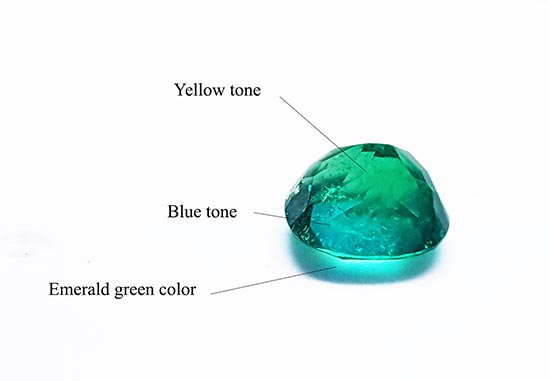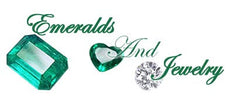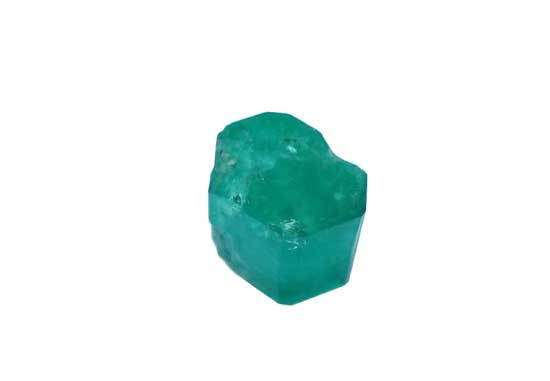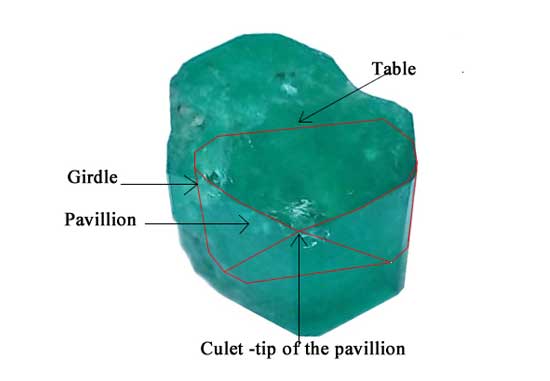Making a price guide per carat for loose natural emeralds is not easy to determine, it depends on where you are looking for the emerald and if there are intermediaries.
How are natural emeralds evaluated?
The price in money or amount of money to pay for a natural emerald depends upon who the seller is and who the buyer is. Reputable companies have to pay high amounts of money for sophisticated advertising campaigns, luxurious location rents, professional salespeople’s payroll and other expenses, such as costs associated with intermediaries and international emerald traders, because they are not going directly to the source, of course, the business owners want all of their invested money returned, plus a good profit. Therefore, it’s normal for their prices to be as high as four times or more compared to our prices for the same identical gem.
Natural emeralds are unique among gems because even cloudy ones can be exceptionally valuable.
Normally the very finest emeralds are in the price range from USD $10,000 to USD $30,000 per carat. But most emeralds present in the commercial jewelry market would be in the price area of USD $500 To USD $3,000 per carat.
Price chart per carat in natural emeralds
How Much do Real Emeralds Cost?
Creating an emerald price chart is a complicated task, because each emerald is unique!
When buyers ask this question, what they want to hear are numbers, amounts in money and nothing else.
The prices shown here are an average per carat, for emeralds of around 2.00 ct. weight, crystalline, good shine, eye clean and good cut; If the emerald has fractures that threaten the integrity of the emerald, or holes in the table, I prefer not to buy it.
If the emerald has visible inclusions such as pyrite or black carbon spots; The price drops considerably, depending on the quantity and size of them, which is why it is impossible to create a price chart for emeralds, the same happens if the emerald is opaque; or with internal clouds, how mild or severe the opacity is.
Colombian emeralds are more desired, therefore more valued, Zambia, Brazil, Afghanistan also produce equally beautiful emeralds like those from Colombia, but commercial demand is what sets the price, not me. and these are the wholesale prices that we manage, according to the prices that we have to pay when we go to buy directly from the source, plus international handling costs.
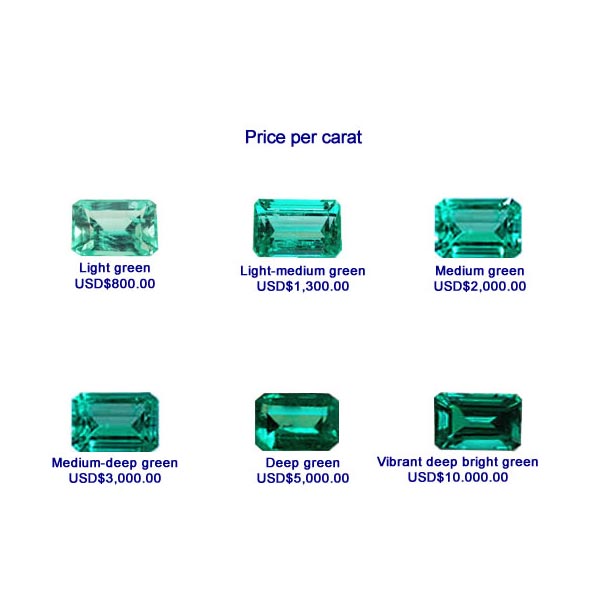
Quality & Grading Standards for Emeralds: an unattainable goal
How much is a natural emerald worth?
Price for emeralds is hard to tell because there is no universal or standard table for grading the quality of emeralds. Most grading is done based upon these four facts:
- Carat weight or size of the gemstone
- Color: hue, brilliance, tone and saturation
- Clarity: visibility of inclusions and flaws
- Cut: how well the stone is cut
A fine emerald can be more expensive than a high quality diamond of the same carat weight. Emeralds are relatively hard stones — 7.5 to 8.0 on the Mohs scale — but the presence of natural internal cracks and many inclusions can affect their solid structure.
Color in Emeralds: Color is the single most important factor when evaluating emeralds. The more attractive the color, the higher the value. Bright and intense colors are valued over those that are dark or too light. Colors that are dulled by tones of brown are less desirable.
Colombian emeralds are among the world's most beautiful, with vibrant green color often kissed with a touch of blue. Almost all rough natural Colombian emeralds have two tones — yellow and blue — and the tonality of each already cut emerald depends upon its natural shape of the rough stone found in the mine. If the cutting angle can be focused to catch the combination of both tones (yellow and blue), the stone will be a beautiful green hue color. If not, then the emerald will be more yellow or more bluish depending on the angle of cut. Bluish emeralds are more desirable and more valuable. See photos of the rough emerald below.
You will see many different terms describing color and quality on many different websites such as: AAA quality; signature quality; top green; rich grass green; green-blue; blue-green; greenish blue; bluish green; etc. Your personal taste is more important than sophisticated qualifications, don't be impressed with apparent masters of the best. See how the gem will look mounted or on the mounting already done (ring, pendant, earrings, etc.) and notice how it catches and reflects the light at different angles. Think about how you feel about the color. Do you prefer dark green, medium green or light green? Regarding the fact that the darker the emerald, the better is relative.

Color comparison.
Two different natural emeralds of similar size and price:
Emerald #1 - with 3.03 carats weight a Medium-deep bluish green color, it is currently one of my loose emeralds for sale (LEM 306) and is certified, priced at USD $2,000.00 per carat, it is a clear, vibrant crystal (very bright), "almost eye clean" but not perfectly clean (not $3,000.00 X ct.), its cut is the most desired, the most valued, you have to pay for the most desired thing. If this emerald were a deep green color, like #2 color, its price would rise to more than USD $10,000.00.
Emerald #2 with 3.13 carat weight, deep bluish green color, is also currently one of my loose emeralds for sale (LEM 302) and is NOT certified, with a price of USD $3.000.00 per carat, it is a beautiful non-transparent, a brilliant crystal , "eye clean" if it were more crystalline (transparent) and very shiny, its price would be above USD $10,000.00 X ct., its baguette cut in this size is not the most popular for common jewelry, only for special designs and taste.
Clarity in Natural Emeralds
Clarity: it’s a purity thing - Many gems have tendencies to be more included than other varieties. For example, emeralds are known to be far more included than sapphires. The clarity of gems is determined by judging the amount and location of inclusions and flaws seen. Basically, the higher the clarity grade, the higher the value of the emerald.
Most emeralds contain tiny natural features called inclusions. which are small particles of minerals (black carbon spots), gas, liquids, and other crystals that emeralds take on during the crystallization process.
The flaws, are imperfections of the crystallization process itself, mostly eye visibles, easier to analyse under magnification like a 10x loupe. They are also called “Jardin.” or “gardens” because they look like tree branches and plant roots; they are like fingerprints or birthmarks unique in every single individual gemstone presented with its own internal “garden” If the inclusions and flaws are mild and do not interfere with the brilliance, sparkle and fire of a gem, then they don’t affect dramatically the value of the emerald. Remember it is normal for you to see tiny flaws and inclusions in an emerald because it is a natural component of this gem.
Impurities are normal inclusions in natural emeralds
Inclusions are Particles of Formation Other Than Beryl or Emerald - No Flaws
Natural emeralds like other gems were formed deep in the earth, therefore any amount of minerals and other crystals are natural particles included (an intruder) into de emeralds.
Around 75% of each raw emerald is lost in the cutting process, to leave the cleanest part, but there are some emeralds that are very included that have no option but to leave them like it is with all the inclusions.
Although these emeralds are beautiful crystals, they are of much less value than clean ones and are used as souvenir jewelry in silver, at a commercial price between USD $50.00 to USD $300.00, depending on the crystalline or opaque and color of the emerald.
The emerald #1- It is a transparent bluish green color crystal, it is more desired and valuable than #2- which is opaque, not translucent or no crystalline.
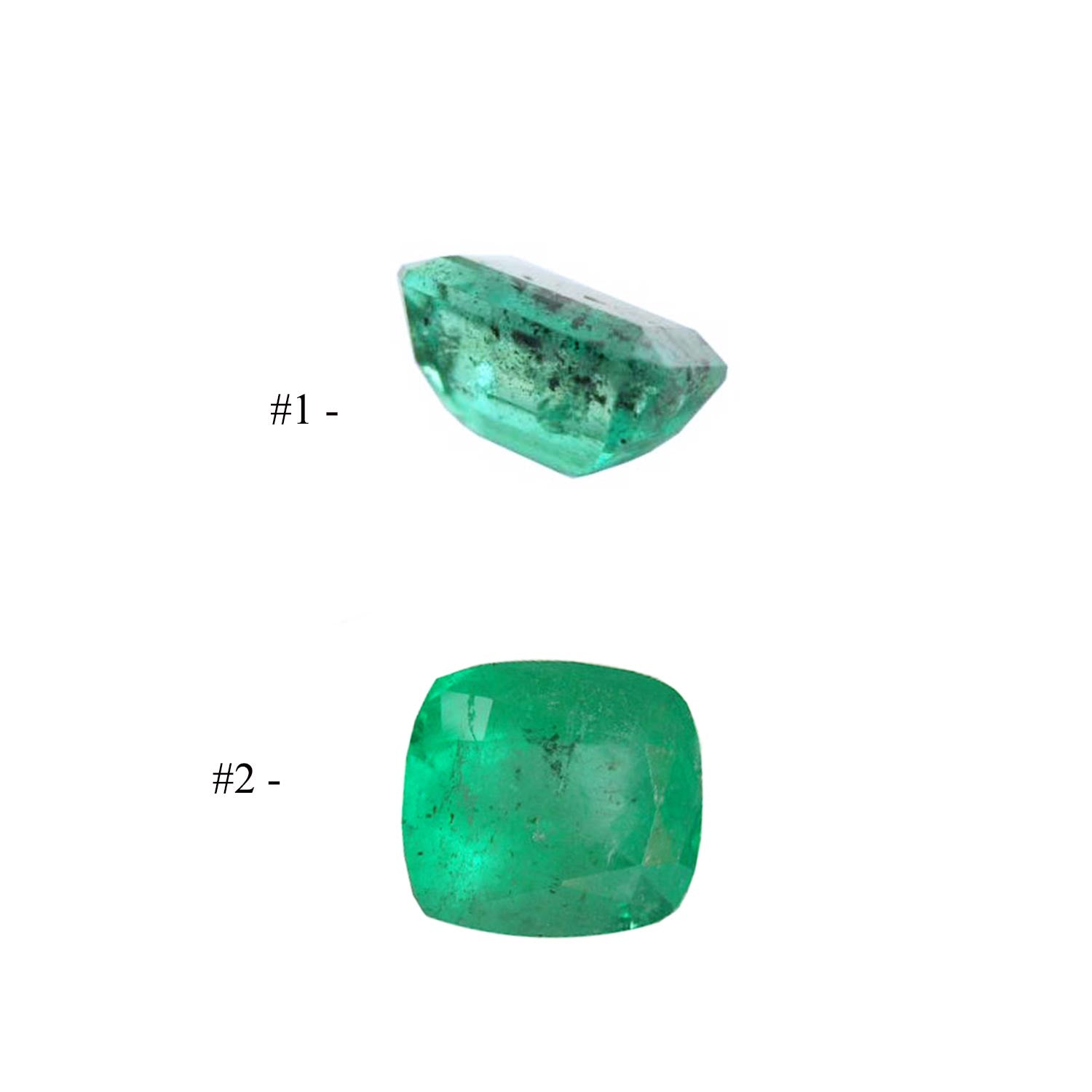
The final shape of an emerald depends on the shape it was found in the rough.
Cut and Polish in Emeralds
Cut and Polish: Unlike diamonds, emeralds possess variable optical properties and are not cut to a uniform ideal. A well-cut emerald exhibit even color, a minimal number of inclusions, good brilliance and shows more apparency of carat weight when viewed on the top. A well-cut emerald should also exhibit good symmetry and polish condition.
Cut and Polish: in rough emeralds, a hard decision to make, only for experts!!!
From 60% to 70% of the rough emerald is lost in the cutting process.
To achieve this quality, it is necessary to discard 70% of the raw emerald and leave only the clean and shiny crystal.
The final result is an emerald with its two colors focused from the pavilion towards the table already combined, in this case the emerald is bluish green color because the blue is the predominant color and best positioned within the emerald, but it could also be the other way around, a slightly yellowish emerald, in both cases it is beautiful and very valuable emerald for its brilliance, transparent and very bright crystalline material.
